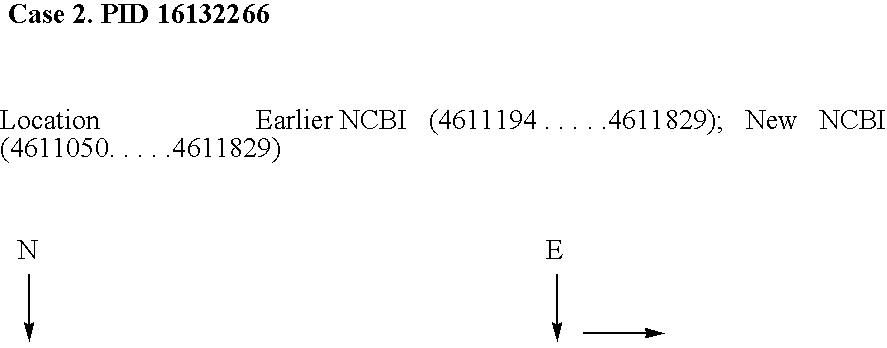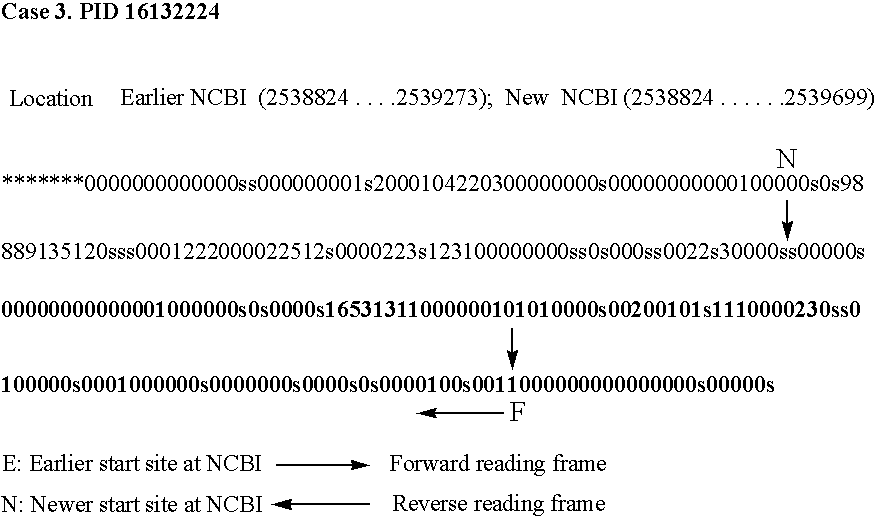Computer based versatile method for identifying protein coding DNA sequences useful as drug targets
a technology of protein coding dna and computer-based versatile methods, which is applied in the field of computer-based versatile methods for identifying protein coding dna sequences useful as drug targets, can solve the problems of inability to efficiently predict small-length genes, difficulty in getting sufficient data to estimate training parameters, and methods less suitable for analyzing small genomes
- Summary
- Abstract
- Description
- Claims
- Application Information
AI Technical Summary
Benefits of technology
Problems solved by technology
Method used
Image
Examples
example 1
Conversion of DNA Sequence into Alphanumeric Sequence
[0122] The purpose of this module in our software is to translate computationally the whole query genome (DNA sequence) in all six reading frames using a specified codon table. Applicants used letter ‘z’ corresponding to the stop codons TTA, TAG and TGA, and letter ‘b’ for all triplets containing any non standard nucleotide(s) (K, N, W, R, and S etc.) while artificially translating the genome. Subsequently the translated genome sequence is converted computationally into an alphanumeric sequence ([0-9], ‘s’, ‘*’, and ‘-’). Applicants search each overlapping heptapeptide in the peptide library, assign a corresponding number (occurrence value), and append it to the alphanumeric sequence. If a heptapeptide is not present in the library applicants assign the number 0. If a heptapeptide begins with an amino acid corresponding to any of the start codon ATG, GTG and TTG Applicants append character ‘s’ in the alphanumeric sequence. This ...
example 2
Training of Artificial Neural Network (ANN)
[0136] The purpose of this module in the software is to train the designed neural network (FIG. 2) with a specified no. of genes and non-genes. In this example the training set consists of 1610 E. coli-k12 NCBI listed protein coding genes and 3000 E. coli-k12 ORFs which have not been reported as genes (non-genes). The validation set has 1000 known genes and 1000 non-genes from E. coli-k12, distinct from those used in the training set. The test set contains another 1000 genes and 1000 non-genes from the same organism. For training of the ANN, genes and the non-genes are assigned a probability value of 1 and 0 respectively. To train the neural network, first applicants convert all the E. coli-k12 genes and non-genes into corresponding alphanumeric strings by the method described above (steps 2 and 3). Samples of two E. coli-k12 genes and two non-genes in alphanumeric sequence format are shown in FIG. 3. Here it is important to note that the...
example 3
[0140] The applicants have analyzed 10 prokaryotic genomes using the method of invention. Efficiency of the method has been defined as percentage of the NCBI listed protein coding regions predicted by said method. All the encapsulated protein coding regions have been eliminated automatically by a specifically developed program. The method is able to predict on an average 92.7% of the NCBI listed genes with a standard deviation of 2.8%. Both sensitivity and specificity values of the method are high except in M. tuberculosis H37RV genome (as shown in FIG. No. 3).
PUM
 Login to View More
Login to View More Abstract
Description
Claims
Application Information
 Login to View More
Login to View More - R&D
- Intellectual Property
- Life Sciences
- Materials
- Tech Scout
- Unparalleled Data Quality
- Higher Quality Content
- 60% Fewer Hallucinations
Browse by: Latest US Patents, China's latest patents, Technical Efficacy Thesaurus, Application Domain, Technology Topic, Popular Technical Reports.
© 2025 PatSnap. All rights reserved.Legal|Privacy policy|Modern Slavery Act Transparency Statement|Sitemap|About US| Contact US: help@patsnap.com



